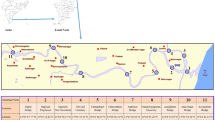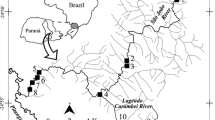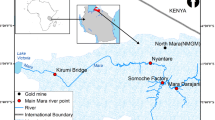Abstract
This study is carried out to evaluate potentially toxic metal concentrations (As, Cd, Cr, Cu, Hg, Mo, Ni, Pb, and Zn) together with their spatial distribution, degree of pollution, and potential ecological risk in Kor river sediments (southwest Iran) using sediment quality guidelines, geoaccumulation index (I geo), Hakanson potential ecological risk index (RI), and standard methods of statistical analysis. The study area stretches some 140 km from the Drodzan Dam to Bakhtegan Lake, a stretch of river where different industrial and domestic activities (e.g., petrochemical complex, oil refinery, industrial meat processing complex, Marvdasht city sewage) and ecological value overlap with each other. Calculated geoaccumulation index indicate that 50 % of the stations are moderately to very extremely polluted. The potential ecological risk for nine investigated metals in Kor river is Hg (948) > Mo (51.9) > Ni (37.8) > Cd (29.8) > As (22) > Cu (16.6) > Pb (13.3) > Zn (3.3) > Cr (1). Results show that sediments in parts of Kor river sediments are heavily affected by effluents discharged from industrial plants and other parts are affected by agriculture and urban runoff from nearby lands. These phenomena may cause a risk of secondary water pollution under sediment disturbance and/or changes in the physical–chemical characteristics of the aquatic system.






Similar content being viewed by others
References
ANZECC. (1997). Basis for a national agreement on environmental impact assessment, Australian and New Zealand Environment and Conservation Council.
Chakravarty, M., & Patgiri, A. D. (2009). Metal pollution assessment in sediments of the Dikrong river, NE India. Journal of Human Ecology, 27, 63–67.
Charkhabi, A. H., Sakizadeh, M., & Rafiee, G. (2005). Seasonal fluctuation in heavy metal pollution in Iran’s Siahroud river. Environmental Science and Pollution Research, 12, 264–270.
Devesa-Rey, R., & Barral, M. T. (2012). Allochthonous versus autochthonous naturally occurring organic matter in the Anllóns river bed sediments (Spain). Environmental Earth Sciences. doi:10.1007/s12665-011-1286-3.
Devesa-Rey, R., Díaz-Fierros, F., & Barral, M. T. (2011). Assessment of enrichment factors and grain size influence on the metal distribution in riverbed sediments (Anllóns River, NW Spain). Environmental Monitoring and Assessment, 179(1–4), 371–388.
Forstner, U., & Wittman, G. (1983). Metal pollution in the aquatic environment. Berlin: Springer.
Fukue, M., Yanai, M., Sato, Y., Fujikawa, T., Furukawa, Y., & Tani, S. (2006). Background values for evaluation of heavy metal contamination in sediments. Journal of Hazardous Materials, 136, 111–119.
Gee, G. W., & Bauder, J. W. (1986). Particle-size analysis. In A. Klute (Ed.), Methods of soil analysis. Part 1. Physical and Mineralogical methods. Agronomy Monograph No. 9 (2nd ed., pp. 383–411). Madison: American Society of Agronomy/Soil Science Society of America.
Hakanson, L. (1980). An ecological risk index for aquatic pollution control: A sedimentological approach. Water Research, 14(8), 975–1001.
Heiri, O., Lotter, A. F., & Lemcke, G. (2001). Loss on ignition as a method for estimating organic and carbonate content in sediments: Reproducibility and comparability of results. Journal Paleolimnology, 25, 101–110.
Kannel, P. R., Lee, S., Kanel, S. R., & Khan, S. P. (2007). Chemometric application in classification and assessment of monitoring locations of an urban river system. Analytica Chimica Acta, 582, 390–399.
Khwaja, A. R., Singh, R., & Tandon, S. N. (2000). Monitoring of Ganga water and sediments vis-a′-vis tannery pollution at Kanpur (India): A case study. Environmental Monitoring and Assessment, 68, 19–35.
Klavins, M., Briede, A., & Rodinov, V. (2000). Heavy metals in river of Latvia. The Science of the Total Environment, 262, 175–183.
Linnik, P. M., & Zubenko, I. B. (2000). Role of bottom sediments in the secondary pollution of aquatic environments by heavy metal compounds, lakes and reservoirs. Research Management, 5, 11–21.
Liu, J., Li, Y., Zhang, B., Cao, J., Cao, Z., & Domagalski, J. (2009). Ecological risk of heavy metals in sediments of the Luan river source water. Ecotoxicology, 18, 748–758.
Mathis, B. J., & Cummings, T. F. (1973). Selected metals in sediments and biota in Illinois river. Journal of the Water Pollution Control Federation, 45, 573–583.
McDonald, D. D., Ingersoll, C. G., & Berger, T. A. (2000). Development and evaluation of consensus-based sediment quality guidelines for freshwater ecosystems. Archives of Environmental Contamination and Toxicology, 39, 20–31.
Mil-Homens, M., Stevens, R. L., Cato, I., & Abrantes, F. (2007). Regional geochemical baselines for Portuguese shelf sediments. Environmental Pollution, 148(2), 418–427.
Muller, G. (1969). Index of geoaccumulation in sediments of the Rhine river. Geology Journal, 2(3), 108–118.
Muller, G. (1979). Schwermetalle in den sediment des Rheins, Veranderungem Seit 1971. Umschau, 79, 778–783.
Sakan, S. M., Dordevic, D. S., Manojlovic, D. D., & Predrag, P. S. (2009). Assessment of heavy metal pollutants accumulation in the Tisza river sediments. Journal of Environmental Management, 90, 3382–3390.
Sheykhi, V., & Moore, F. (2012). Geochemical characterization of Kor river water quality, Fars Province, Southwest Iran. Water Quality, Exposure and Health, 4(1), 25–38.
Shi, G., Chen, Z., Bi, C., Li, Y., Teng, J., Wang, L., et al. (2010). Comprehensive assessment of toxic metals in urban and suburban street deposited sediments (SDSs) in the biggest metropolitan area of China. Environmental Pollution, 158, 694–703.
Singh, K. P., Mohan, D., Singh, V. K., & Malik, A. (2005). Studies on distribution and fractionation of heavy metals in Gomti river sediments—A tributary of the Ganges, India. Journal of Hydrology, 312, 14–27.
Subramanian, V., Van Grieken, R., & Van’t Dack, L. (1987). Heavy metals distribution in the sediments of Ganges and Brahmaputra rivers. Environmental Geology, 9, 93–105.
Yalcin, M. G., Tumuklu, A., Sonmez, M., & Erdag, D. S. (2010). Application of multivariate statistical approach to identify heavy metal sources in bottom soil of the Seyhan river (Adana), Turkey. Environmental Monitoring and Assessment, 164(1–4), 311–322.
Zhang, Y., Guo, F., Meng, W., & Wang, X. Q. (2009). Water quality assessment and source identification of Daliao river basin using multivariate statistical methods. Environmental Monitoring and Assessment, 152, 105–121.
Zhou, J., Ma, D., Pan, J., Nie, W., & Wu, K. (2008). Application of multivariate statistical approach to identify heavy metal sources in sediment and waters: A case study in Yangzhong, China. Environmental Geology, 54, 373–380.
Acknowledgments
The authors would like to thank the research committee of Shiraz University and Fars Regional Water Authority for the financial support. Thanks are also extended to Dr. David Moore for critically reading the manuscript.
Author information
Authors and Affiliations
Corresponding author
Rights and permissions
About this article
Cite this article
Sheykhi, V., Moore, F. Evaluation of potentially toxic metals pollution in the sediments of the Kor river, southwest Iran. Environ Monit Assess 185, 3219–3232 (2013). https://doi.org/10.1007/s10661-012-2785-8
Received:
Accepted:
Published:
Issue Date:
DOI: https://doi.org/10.1007/s10661-012-2785-8




